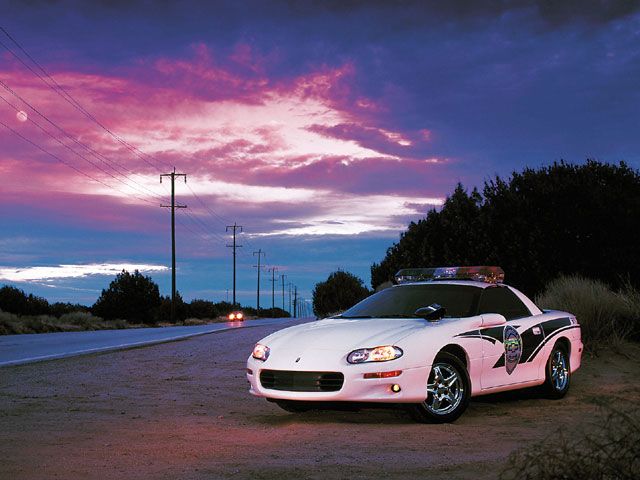
Every few years, the car mags do an article about police cars. Do you ever wonder why? They are the cars that most of us would like to avoid seeing on the road, and generally they are built upon rather bland family sedans that most of us would prefer not to be seen driving. But cop cars do have an appeal to car enthusiasts beyond black-and-white paint and seeing them sliding their cruisers around corners in hot pursuit on movies and TV, because we know that the reality of a cop-car's life is lots of brutal street work requiring hard-core parts to make it live during endless idling and urban patrolling.
The big cruisers are nicely equipped with a variety of heavy-duty and high-performance parts normally not available on their civilian counterparts-things like reinforced frames, extra-capacity cooling systems, and bigger brakes, springs, and sway bars. You know the drill-cop tires, cop suspension, cop shocks. Plus, the cars are usually stripped of their excessive luxury trappings, leaving a purposeful, utilitarian workspace ready and willing to be driven hard when the need arises. And that's why these cars are cool.
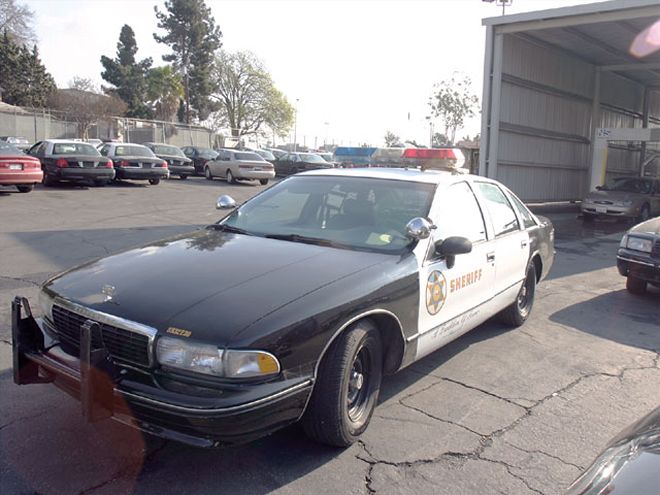
To make a police car, the manufacturers take an otherwise coma-inducing Crown Victoria or Caprice and jettison the tacky chrome trim, overstuffed mouse-fur seats, and shag carpeting. In place of that, they install bucket seats and a rubber floor, hang bigger brakes and sway bars, plumb in a bigger radiator, and a brace of transmission and engine oil coolers. Suddenly, cars destined for the blue-hair set are ready for action.
That's the balancing act the manufacturers face. They have to design their family sedans to appeal to the luxury-car buyer while keeping an eye toward police and fleet service. Why else do you think Chevrolet bothered dropping LT1s into Caprices in 1994? So gramps could get to the Moose Lodge in record time? No, the cops were crying out for more power than the wheezy 180hp TBI engines of the previous models could muster. In speaking with several jurisdictions in Southern California, all their fleet managers agreed that the manufacturers ask for feedback from the departments on how their cars can be improved to better suit service for the police. For example, in 1998, Ford redesigned the rear suspension of the Crown Vic, installing parallel lower training arms and a Watts linkage in place of the former angled upper and lower control-arm design.This improvement addressed complaints from police about the Crown Vic's twitchy handling at speeds exceeding 100 mph. A second, more extensive overhaul followed in 2003, which saw the addition of a hydroformed frame, aluminum suspension arms, rack-and-pinion steering, and inverted, monotube shock absorbers. Who would have thought the Vicky's vanilla exterior belies a performance-car's underpinnings?
The last time CC ran a police-car story was nearly 10 years ago, so we thought the time was right for another look.Plus, the recent big news about DaimlerChrylser's re-entry into the market with police-spec Chargers and Magnums, which has the fuzz all across the United States itching to try out Dodge's latest Hemi-equipped cruiser. We'll spec out the current V-8, rear-drive models as well as some of the notable recent cars. While these are equipped with the cool cop-car stuff that isn't available to the general public, the good news is that you can go to an auction and get your hands on 'em. when the cops are done.
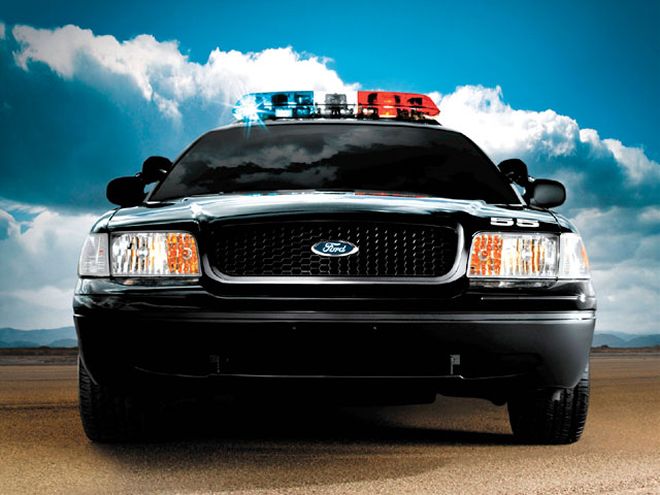
'06 Ford Crown Victoria P71 Police Interceptor*
Ford has been making police cars continuously since 1950, gaining a near monopoly in the business when GM discontinued production of the Caprice in 1996. Though the LT1 Caprices seriously outgunned it at the time, Ford has made steady improvements to the Crown Victoria Police Interceptor (CVPI) since then, making the Vicky a rugged and reliable law-enforcement vehicle. Though rumors had been circulating that Ford would discontinue its fullsize, body-on-frame cars after the '07 model year, it has pledged to continue making the CVPI through 2011. No word yet on its replacement, though it's speculated that it may be based on a revised version of the current Mustang chassis.
To make a Police Interceptor, Ford takes the standard Crown Victoria and adds a 200-amp alternator; engine, transmission, and power-steering oil coolers; a heavy-duty suspension consisting of police-spec springs and shocks; and 235/55R17 tires. Also, there is a choice of a 3.21:1-ratio open diff or 3.55 limited-slip rear axle. Bucket seats, a rubber floor, and extra dome lights (known as "ticket lights") are among the interior differences. In addition, there are a number of police-equipment options available, including strobe lights installed inside the turn-signal and taillamp lenses, inside the grille, and on the rear package tray; wiring harnesses with several high-amperage power pickups; and extra grounds to aid in the installation of communications and lighting equipment.
When shopping for a CVPI at auction, the best cars to buy are the '03-and-later models with the suspension upgrades and slightly higher horsepower ratings. The larger departments tend to turn the units over more frequently than smaller departments and usually perform their own maintenance on a strict schedule. We regularly see prices for '03-and-later CVPIs in the $6,000.00 to $9,000.00 range.
Engine: 4.6L SOHC V-8
Horsepower: 250 @ 5,000 rpm
Torque: 297 lb-ft @ 4,000 rpm
Curb weight: 4,132 lbs.
Brakes
Front: 12.01-inch vented disc
Rear: 11.61-inch vented disc
Acceleration
0-60: 8.44 seconds
Quarter-mile: 16.45 seconds
@ 89.41 mph
Braking
60-0:154.44 feet
Top speed: 130 mph
*Performance info for all vehicles has been compiled from the Michigan State Policeand the Los Angeles Sheriff's Department vehicle-testing data.
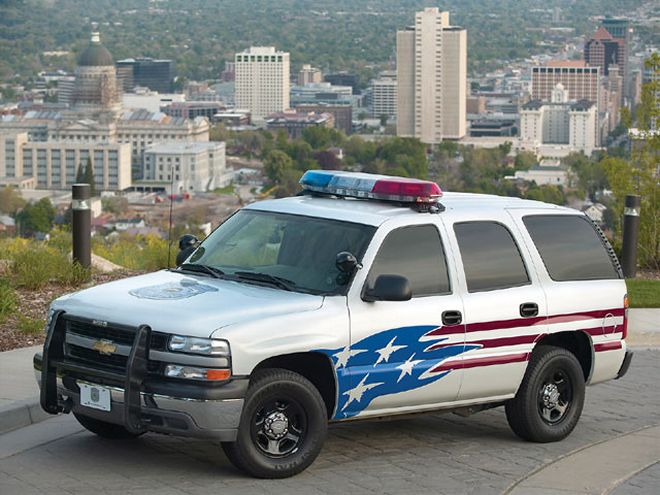
'06 Chevrolet Tahoe Z56 Police Package
The two-wheel-drive Tahoe has the distinction of being the only SUV given a pursuit rating by the manufacturer. Other SUVs, such as the Ford Explorer and Escape and four-wheel-drive Tahoe, are available to the law-enforcement community as a Special Service Package, and not necessarily intended for high-speed pursuit. Though Chevrolet developed the Tahoe police package to fill the gap in the market left by the Caprice, it was never nearly as popular. Its initial cost is higher than the Caprice or Crown Victoria, and, at an estimated 15 mpg, it's not the most fuel-efficient choice available. However, Sergeant Robert Killeen of the Los Angeles Sheriff's Department says that the Tahoe's advantage is its interior space-63.6 cubic feet of cargo area, and, as such, most of his Tahoes are assigned to K9 units or to a field supervisor, who can use the car as a mobile command post at the scene of an accident or other emergency. The cargo area can be fitted to carry an array of equipment or weapons.
Compared to a regular Tahoe, the police version loses its center console and trades the carpeting for a rubber floor mat. It is also available with auxiliary interior lighting and additional power points. Mechanically, the police Tahoes are equipped with 160-amp alternators, a high-capacity air cleaner, transmission-oil and power-steering coolers, a 4-inch balanced aluminum driveshaft, skidplates, police-specific springs, and 3.73 final drive with a limited-slip option.
If you're looking for a police Tahoe at the auctions, try to find a two-wheel-drive version. Its lower center of gravity and upgraded suspension offer better handling than the 4x4 versions. These vehicles are relatively rare versus the CVPIs, so be prepared to pay more for exclusivity. We've seen clean, relatively low-mile units sell for upward of $8,000.00.
Engine: 5.3L OHV V-8
Horsepower: 295 @ 5,200 rpm
Torque: 335 lb-ft @ 4,000 rpm
Curb weight: 5,079 lbs.
Brakes
Front: 12-inch ventilated disc
Rear: 13-inch ventilated disc
Acceleration
0-60: 8.91 seconds
Quarter-mile: 16.80 seconds @ 85.80 mph
Braking: 60-0: 157.48 feet
Top speed: 124 mph
'06 Dodge Charger And Magnum Police Vehicles
The Charger and Magnum likely indicate the future of police cars, and it was a sensible move on the part of DaimlerChrysler to make a police version of its popular rear-drive sedans now. They will have had a few years of service to evaluate the performance before Ford either redesigns the Crown Victoria or shifts the police-car model to a different vehicle line. It's likely, though, that we will be seeing the end of perimeter-frame police sedans when that happens. The Charger and Magnum are Unitbody cars with independent rear suspension. And, yes, they are available with the Hemi engine, which turned in blistering performance numbers compared to its rivals in performance evaluations conducted by the Los Angeles County Sheriff's Department last October, where it out-handled, out-braked, and out-accelerated all other cars tested. Plus, with an average of 19 mpg during testing, it was the most fuel-efficient of all V-8-powered cars, thanks to its five-speed automatic transmission and Multi-Displacement System, which deactivates half of the cylinders when less power is needed.
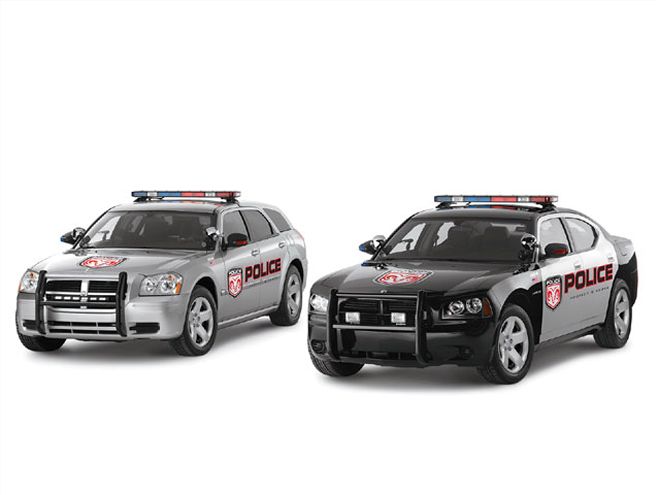
Other police-specific kits that can be had with a Charger/Magnum police package are an upgraded braking system with better pads, bigger rotors, and a larger master cylinder; blacked-out 18-inch steel wheels; and unique programming for the Electronic Stability Program. The usual goodies are included also-the Dodge cop cars get 160-amp alternators; engine, transmission, and power-steering oil coolers, and ticket-writing lights. Another cool feature unique to these cars is the wigwags, or alternating flashers for the head- and taillights, which are available directly from Dodge and saves some of the time and cost of prepping the cars for service.
The LAPD and Los Angeles County Sheriff's Department are sticking with the Crown Victoria for the next couple of years at least. Sergeant Killeen from the LASD's Fleet Management Unit puts it very simply: He's not going to retool unless he has to. Since he operates on a very large volume-over 1,500 cars at any given time-his operation needs to be as efficient as possible. Most of the parts to modify the CVPIs to duty as sheriff's patrol cars are manufactured in-house-they make their own prisoner barricades, pushbars, radio and computer mounts, even wiring harnesses to power the lights, sirens, and communications systems. And these can get fitted to newer cars as the older ones are retired. He says the beauty of the Crown Victoria is that he can take virtually any of the parts from a '98 cruiser and fit them into one of the '07s. It would be cost-prohibitive for them to change their operation at this point because they would have to design all-new templates for those pieces.
For smaller departments, the cost involved with switching a fleet to Dodge cruisers would not be so great, however, and we spoke to personnel in the Glendale Police Department who are in the process of evaluating three Chargers and two Magnums. Patrick Hennigan, the equipment maintenance supervisor for the Glendale PD, is impressed with the cars so far, but says that the cops are the final judges. "The cars are their office for 12 hours a day, and I'll hear about it if they don't like something," he says. Things like radio placement, computer mounting systems, and elbow room may be more important to the officers than quarter-mile times and braking distances, considering that much of their patrolling is done at low speeds in a crowded, urban environment. The Glendale, California, PD will be evaluating the new cars for reliability and user-friendliness to determine whether to switch the entire fleet over to Dodge. A clear advantage for the Dodge is fuel economy. The cylinder-deactivation system could potentially save departments thousands of dollars per month on fuel expenses.
The Chargers and Magnums used by the Glendale Police Department are unmarked units and are on a five-year depreciation schedule, after which time they will be sent to an auction house. So, it may be a few years before you can get your hands on a retired Hemi-powered cruiser.
Engine: 5.7L OHV V-8
Horsepower*: 340 @ 5,000 rpm
Torque: 390 lb-ft @ 4,000 rpm
Curb weight: 4,106 lbs.
Brakes
Front: 13.6-inch ventilated disc
Rear: 13.8-inch ventilated disc
Acceleration
0-60: 6.52 seconds
Quarter-mile: 14.96 seconds
@ 99.2 mph
Braking
60-0: 137.50 feet
Top speed: 150 mph
(electronically limited)
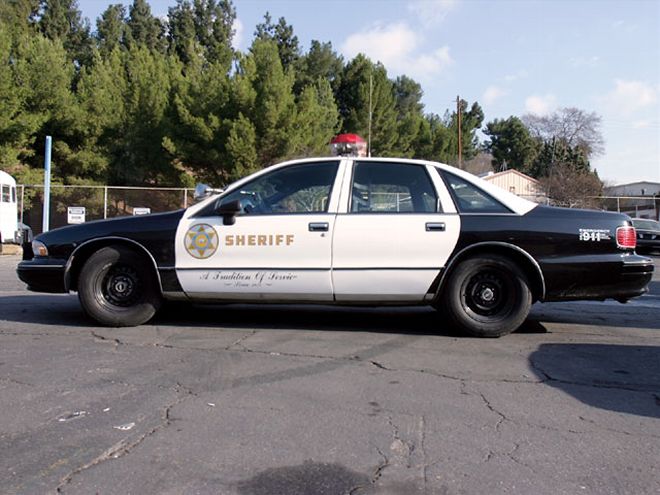
Notable Past Cars
Give GM credit: The Caprice was killed when it was at the top of its game. The '96 was one of the quickest, fastest, and best-handling and -braking police sedans ever produced. Only the '69 440 Magnum-powered Dodge Polara was faster. Its performance was nearly identical to the Special Service Package Fox-bodied 5.0 Mustangs that were used in many jurisdictions as highway patrol cars. The LT1 engine, first available in the '94 Caprice, represented a 30-percent increase in power over the previous model year's TBI 350, and the difference in performance was staggering. Acceleration times dropped to levels not seen since the big-block era of the '70s, and the cars were also steady at high speed and had capable handling in spite of their weight. They won five out of six phases of the Michigan State Police patrol-car tests in 1995. The 9C1 police package started off with a reinforced frame and added stiffer springs, shocks and sway bars, four-wheel disc brakes, a 140-amp alternator, and coolers for all fluids. Look for the distinctive green silicone coolant and heater hoses specific to police cars. The 15-inch black-powdercoated steel wheels with bolt-on center caps were also a police-only option.
Though the Caprice has been out of production for 11 years, there are a handful of them still patrolling the streets. The LASD has a number of '94s still hanging around. Sargeant Killeen told us that during a budget crisis several years ago, many of these cars were refurbished rather than retired for half the cost of buying new models. Refurbishing police cars is not unlike a restoration-the engine and transmission are replaced with new or rebuilt units, and the car gets a thorough mechanical and cosmetic overhaul. These refurbished '94s are slowly getting phased out, and it is a very real possibility to see one of these cars on auction soon.
When shopping for a 9C1, the '94-'96 cars are by far the most desirable and prices still can climb over $6,500.00 for unmarked, lower-mileage ones or $3,000.00 for black-and-whites. Beware, though, that the L99 4.3L V-8 was also an option for these years and looks the same as an LT1 under the hood. Check for a P as the eighth character of the VIN to verify the LT1 engine. The L99 cars are VIN W. In a hurry? All LT1 cars had true dual exhaust; the L99 cars ran a single tailpipe. '93-'02 Chevrolet Camaro B4CIn 1979, 12 Camaros were tested by the California Highway Patrol to ascertain their potential as traffic-enforcement vehicles, but it wasn't until 1991 that Chevrolet equipped the Camaro with the official B4C Special Service Package, making it available as a traffic-enforcement car. Originally powered by 305 and 350 TPI engines, the '93 model year brought the fourth-generation LT1 cars to market. Interestingly, a six-speed manual transmission was available as well as the 4L60E automatic. In '98, the LS1 replaced the Gen II small-block and served through the remainder of the model's run until GM discontinued production of the F-car in 2002. The LS1 could also be paired with the six-speed box or four-speed automatic.
'94-'96 Chevrolet Caprice 9C1
Engine: 5.7L OHV V-8
Horsepower: 260 @ 5,000 rpm
Torque: 330 lb-ft @ 2,400 rpm
Curb weight: 4,221 lbs.
Brakes
Front: 12-inch ventilated disc
Rear: 11.6-inch ventilated disc
Acceleration
0-60: 7.1 seconds
Quarter-mile: 16.4 seconds @ 135 mph
Braking
60-0: 120 feet
Top speed: 135 mph
'93-'02 Chevrolet Camaro B4C
In 1979, 12 Camaros were tested by the California Highway Patrol to ascertain their potential as traffic-enforcement vehicles, but it wasn't until 1991 that Chevrolet equipped the Camaro with the official B4C Special Service Package, making it available as a traffic-enforcement car. Originally powered by 305 and 350 TPI engines, the '93 model year brought the fourth-generation LT1 cars to market. Interestingly, a six-speed manual transmission was available as well as the 4L60E automatic. In '98, the LS1 replaced the Gen II small-block and served through the remainder of the model's run until GM discontinued production of the F-car in 2002. The LS1 could also be paired with the six-speed box or four-speed automatic. The manual-trans cars got 3.42:1 final drive ratios, while the slushboxes got 3.23 gears. The B4C package also included a 140-amp alternator, auxiliary fluid coolers, and specific springs and shocks. The sirens were usually mounted behind the front fascia below the turn-signal lenses, requiring a grid of small holes to be cut into the bumper cover--one quick way to identify some of these cars. Not many B4C Camaros were made, so finding one at an auction may be difficult. They will cost more, too. In checking some listings on eBay, we saw the LS1 cars selling for around $10,000.00. Some are still in service; the California Highway Patrol currently uses a few of these cars, so diligent buyers may still be able to get a newly retired unit.
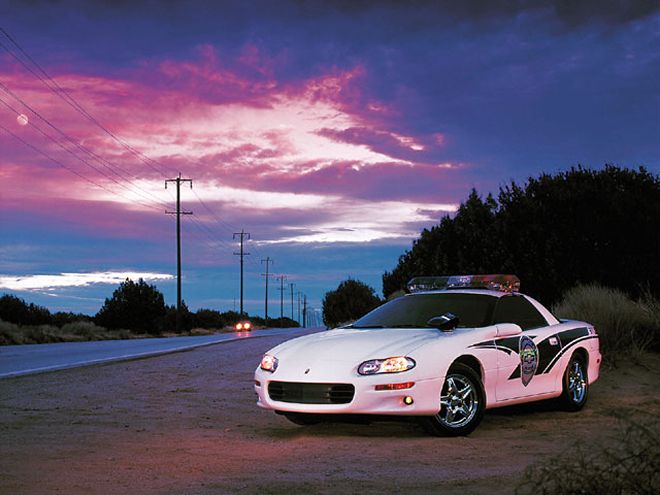
Engine: 5.7L OHV V-8
Horsepower*: 310 @ 5,200 rpm
Torque: 340 lb-ft @ 4,000 rpm
Curb weight: 3,462 lbs.
Brakes
Front: 11.8-inch ventilated disc
Rear: 11.85-inch ventilated disc
Acceleration
0-60: 5.77 seconds
Quarter-mile: 14.44 seconds
@ 102.48 mph
Braking
60-0: 141 feet
Top speed: 159 mph
*All specs taken from '98-'02 LS1 cars *Performance info for all vehicles has been compiled from the Michigan State Policeand the Los Angeles Sheriff's Department vehicle-testing data.
Buying a used police car
Police cars can live very tough lives. They may spend hours on end idling on the side of the road, they get driven hard through potholes and over curbs in urban settings, they chase down bad guys on the open highways, and they even get shot at. But they are usually maintained religiously by their departments-money spent on regular maintenance is much less than the cost of turning over the fleet more frequently than they have to. Still, it would be wise to scout out the local auctions before you buy. See which jurisdictions the cars are from and try to contact the fleet manager of that department to find out the maintenance regime. In talking with local departments, we found that they end up retiring their black-and-white patrol cars after about three years of service, while the unmarked cars are kept a couple of years longer. By then, the mileage is usually within striking distance of 100,000 miles, which, if the cars are well maintained, is not anything to worry about.
Prefer to shop from the comfort of your sofa? There are several online retailers who specialize in selling police cars. Google "used police cars" and you'll be up to your eyeballs in Crown Victorias. Of course, eBay is another viable option, and a good way to monitor the trend in pricing and value of the various models. Now get out there and patrol your own beat.